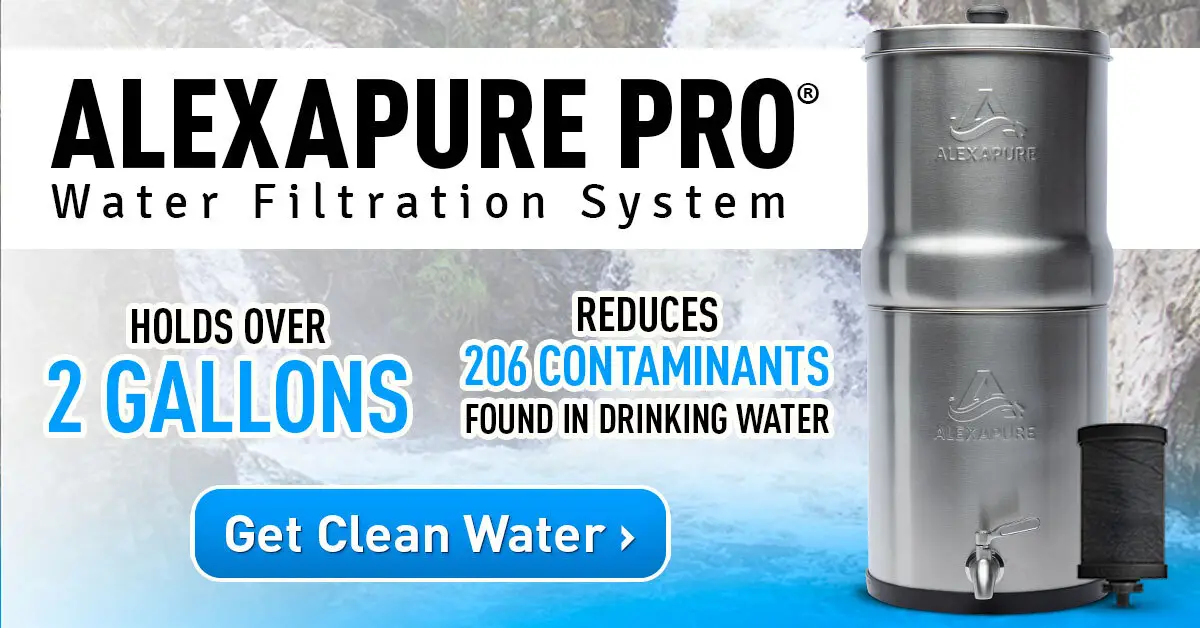How To Block IR Infrared Thermal Imaging
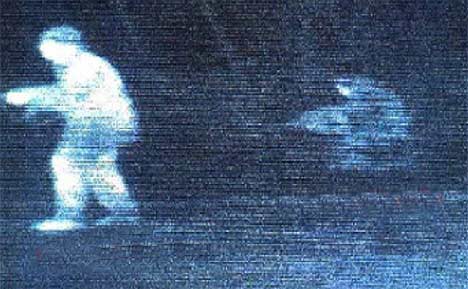
A warm body can be detected by thermal imaging equipment from its IR (Infrared) heat signature. It’s a difficult challenge to avoid detection, be it animal or human. Warm blooded. Want some tips how to hide from thermal imaging?
You may be camouflaged in the best concealment there is, but highly visible to IR thermal imaging on the ground or maybe a drone flying overhead.
Same thing for any warm or hot equipment that you may wish to conceal.
It is difficult to defeat infrared thermal imaging optics.
However there are some techniques that make detection more difficult.
What is Infrared (IR)?
It’s light that’s not visible to the human eye. It’s electromagnetic radiation with longer wavelengths than visible light.
Infrared extends from the red edge of the visible spectrum at 700 nanometers (frequency 430 THz), to 1 millimeter (300 GHz).
Most of the thermal radiation emitted by objects near room temperature is infrared.
Humans actually emit (instead of just reflecting) at IR wavelengths. Our normal body temperature radiates chiefly within the thermal infrared region of (8 – 15 µm) or (0.008 – 0.015 millimeters) – a frequency range of 20–37 THz.
That’s right in the infrared and is detectable by sophisticated modern instrumentation.
Thermal imaging devices can ‘see’ you. They create images based on differences in surface temperature by detecting infrared radiation (heat) that emanates from objects (e.g. your body or that of an animal) and their surrounding environment.
How to Hide from Thermal Imaging Heat Signature
Emergency Thermal Mylar Blanket
One way to hide from thermal imaging is an ordinary ‘space blanket’, ’emergency blanket’ or thermal blanket.
They are made of Mylar foil materials and will block IR imagery.
This one is heavy duty:
Thermal reflective tarp with grommets.
EFFECTIVE AS A TEMPORARY SHELTER WITH IR BLOCKING CHARACTERISTICS:
Thermal, Reflective Tarp
(view on amzn)
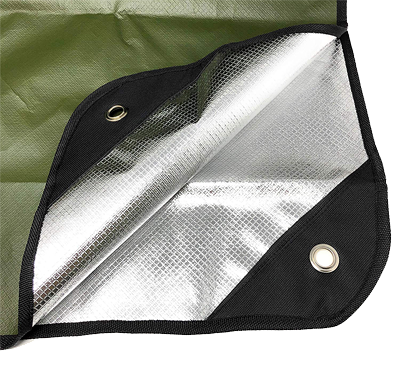
*** EMERGENCY MYLAR BLANKETS
(view on amzn)
Note: The foil will block the IR heat signature behind it. Though keep in mind that heat will build up inside or underneath. Some heat will escape around edges and openings.
Some of that escaping heat may be somewhat visible to IR thermal imaging devices but to a much lesser extent than otherwise.
UV Protection Umbrella
An umbrella designed with materials to provide protection from the sun’s ultraviolet rays. Not only will it provide rain protection, but it will help keep you cool during those hot days! Many of them have a shiny ‘silver’ surface on the top. You may or may not want that…depending what you’re looking for.
Here’s a full size UV protection umbrella with a dark green exterior:
Golf Umbrella
(amzn)
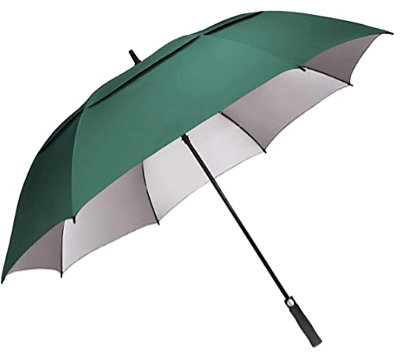
Heavy Blanket
Another way to hide from thermal imaging is to use a heavy blanket or wool blanket for a quick temporary method of IR concealment. Throw a blanket over yourself. A thick woolen blanket will help defeat thermal imaging. It works surprisingly well.
Emergency Wool Blanket
(view on amzn)
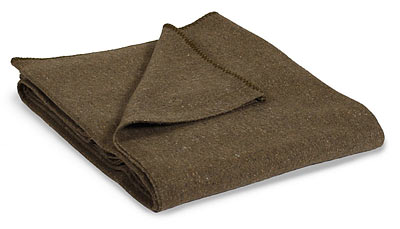
Covering with a layer of insulation (blanket), the heat is blocked (or partially blocked) so that it doesn’t radiate. This is only temporary concealment as the heat builds beneath the blanket. It may work long enough to conceal during a quick TI scan or Drone flyover…
Glass
One of the most effective methods to hide from thermal imaging (to block IR) is to conceal behind glass. Glass is entirely opaque to thermal imaging.
It’s not a practical solution though, due to the obvious impracticality of movement or ‘on-the-go’. But it’s good to know.
Netting Materials
Thick Netting will help. Especially visible detection.
The holes throughout the netting / webbing will help disperse heat signature from thermal IR heat detection.
Netting will help to disperse the heat or hot spots that may be underneath as the airflow will be somewhat broken up by the webbing.
For stationary use, place netting material above, in addition to utilizing the thermal reflective tarp that I just mentioned.
Thick Netting: Camo
(view on amzn)
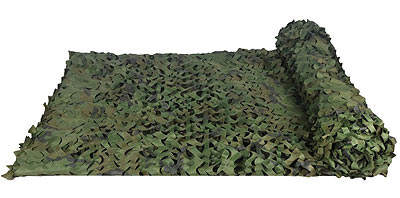
The heat signature will not be as intense, but spread out more. An example may be to cover a vehicle that has been running with netting. Best to leave some air gap between the material and hot surface (prop it up or hang it above).
Blending in with other heat sources
Concealment by blending in next to other warm objects, like warm stones or thick walls that may still be holding the heat from the day.
The vents in buildings may be out-flowing warm air; a source of heat that can help obscure your own thermal outline.
You get the idea… wherever there is existing natural or man-made heat, you can blend in with that to help conceal your presence to an IR or thermal imager.
Wear a Ghillie suit
A Ghilie suit will certainly help disperse your heat signature. It won’t block it, but it will help diffuse a heat signature.
Adult Ghillie suit
(view on amzn)
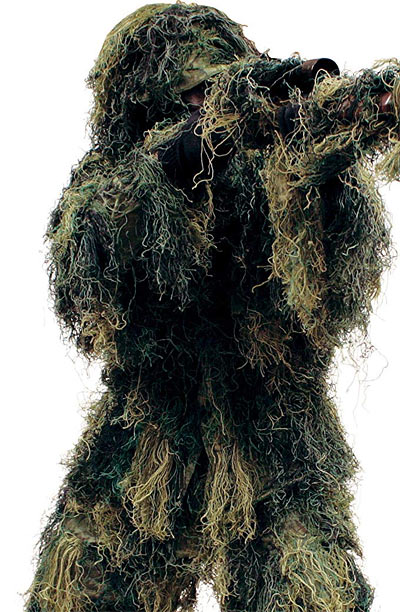
Wear an insulated jacket
Insulated pants and a hat. It won’t be 100% but it will help lessen the heat signature. Again, the heat will build and escape through the neck openings and face. You could cover your face with cool mud, which will work temporarily.
It’s all pretty much common sense; reduce, disperse, or cover the sources of heat.
Objects between You and the Sensor
Put trees and/or brush between you and the suspected IR imager. Trees overhead will help break up the infrared signature, especially under a heavy canopy of leaves.
Stationary vs. Movement
A moving heat signature at night is quicker to identify than a stationary one (up to a point).
[ Read: Avoid Detection By Moving SLOWLY ]
More Tips
When you are hiding your heat signature (with a Mylar emergency blanket or other means), under some conditions your signature may look ‘too cold’ to an IR scan of the area (an extra dark outline, or a ‘black hole’), which may make you detectable.
The problem with most IR cloaking methods, IR clothing or netting designed to block IR, is that it will also block the background IR – creating a black hole of varying degrees. Ideally you would want something that ‘cloaks’ or blends your IR signature such that the background scatter at your location is what the observer sees.
Avoid open spaces and skylines by day or night.
Thermal Imaging does not perform well in falling rain.
[ Read: 10 Tips To Camouflage – Movements & Evasion ]
NIGHT VISION DEVICES: The following distributor is top notch for Night Vision and Thermal Imaging equipment. I happen to have one of their PVS-14 NVD’s and it has been great. Check out their company. Ask for Bob:
Among the highest priorities for survival is safe drinking water.
AlexaPure Pro Gravity-Powered Water Filtration
Tested against NSF/ANSI 53, NSF/ANSI 42
